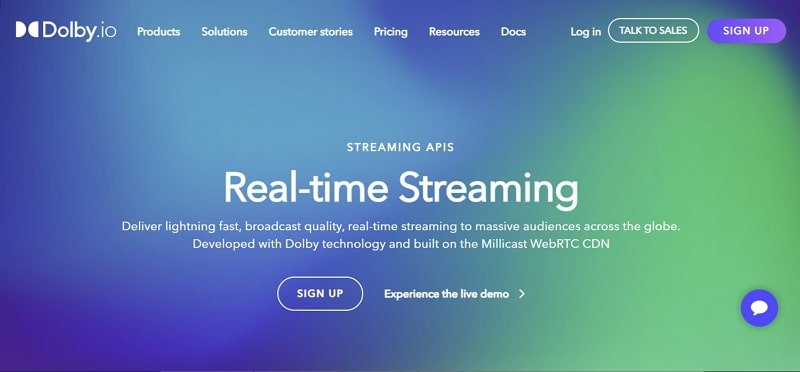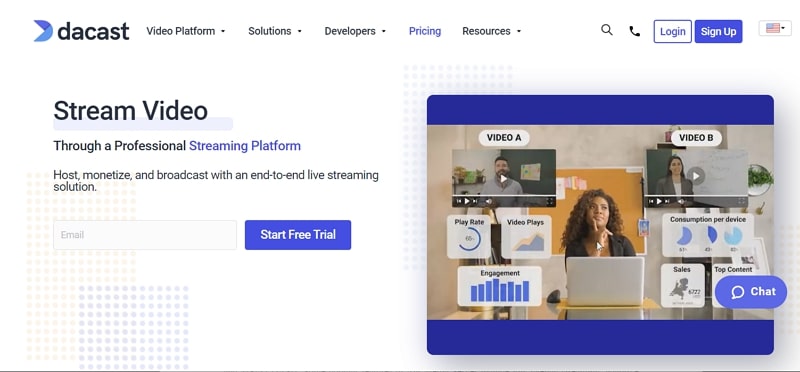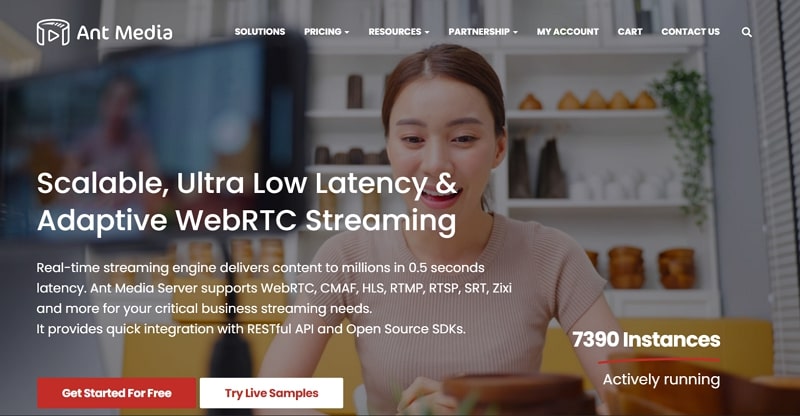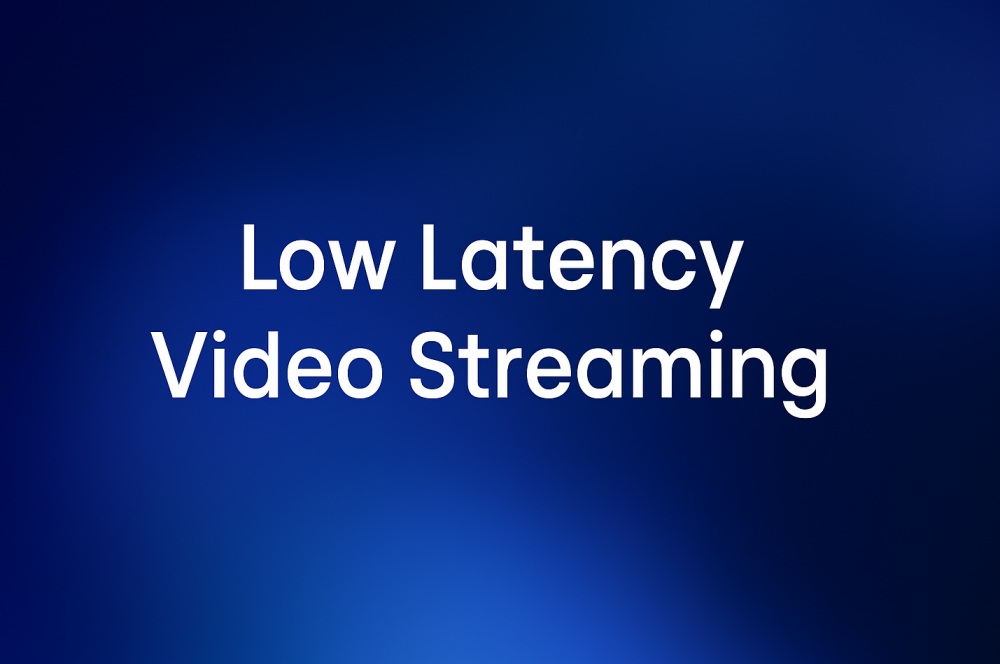Understanding low-latency video streaming is crucial in today’s digital era, where real-time interaction and seamless video playback are not just desired but expected. This technology enables instant video transmission over the internet, reducing delays to a minimum and ensuring that live streaming experiences are as close to real-time as possible. Whether it’s for gaming, live events, or video conferencing, low-latency streaming plays a pivotal role in delivering content efficiently and without frustrating lags, making it a key component in modern digital communication.
What is Low Latency Video Streaming?
It refers to the practice of reducing the time delay between the video content recording time and when you, as a viewer, see it. Simply put, it takes a video stream to travel from the source to the end viewer. The lower the time is, the lower the latency, which in turn ensures, the more real-time the video experience becomes.
Latency is an essential factor in video streaming, especially in applications requiring real-time interaction, such as live streaming or gaming. High latency causes delays between the user’s actions and what viewers see, making the experience feel sluggish or out of sync. Low latency video streaming is usually achieved through a combination of factors, like specialized encoding techniques, faster internet connections, and optimized network infrastructure.
Why Do We Need Low-latency Streaming?
Low-latency streaming is essential for several reasons, particularly in applications and services where real-time interaction and immediate feedback are critical. Here are some of the key reasons why low-latency streaming is necessary:
1. Enhanced User Experience
Low-latency streaming significantly improves the user experience by minimizing delays between the broadcaster and the viewer. This is crucial for maintaining engagement and satisfaction, especially in live events where viewers value the feeling of being part of the action in real-time.
2. Real-time Interaction
For applications like video conferencing, online gaming, and live auctions, real-time interaction is paramount. Low-latency streaming ensures that communication and actions are synchronized among participants, fostering a more natural and effective interaction.
3. Competitive Advantage
In sectors like financial trading or eSports, where milliseconds can make a significant difference, low-latency streaming provides a competitive edge. It enables faster decision-making and reaction to live events, which can be critical for success.
4. Improved Quality of Service
Reducing latency contributes to a smoother, buffer-free streaming experience, which is vital for retaining viewers and subscribers. High latency can lead to interruptions, buffering, and a frustrating viewing experience, leading users to seek better alternatives.
5. Enabling New Technologies and Applications
Low-latency streaming is a key enabler for emerging technologies and applications, such as virtual reality (VR) and augmented reality (AR), where delays can disrupt the immersive experience. It also plays a crucial role in the development of remote surgery, autonomous vehicles, and other applications requiring real-time data transmission.
6. Compliance with Industry Standards
As the demand for live streaming grows, so do the expectations for quality and speed. Low-latency streaming helps content providers comply with industry standards and meet or exceed viewer expectations for live content delivery.
Who Needs Low Latency Video Streaming?
Low latency video streaming is indispensable across various sectors where real-time interaction and swift response are critical. Live sports broadcasters and online gaming platforms stand out as primary beneficiaries. In these fields, even minimal delays can significantly impact the viewer’s experience and engagement levels. The immediacy provided by low latency streaming ensures that fans and gamers receive data and visuals in real-time, closely mirroring a live, in-person experience.
Similarly, financial institutions and traders rely heavily on low latency streaming for the real-time analysis and execution of trades. In the high-stakes world of financial trading, milliseconds can represent the difference between substantial gains and losses. Healthcare is another sector that benefits greatly from low latency streaming, particularly in telemedicine and remote surgeries, where immediate feedback is crucial for patient care and surgical precision.
Educational institutions and corporate training programs also leverage low latency video streaming to facilitate interactive learning experiences. This technology allows for a more engaging and dynamic educational environment, where students and participants can interact with instructors in real time. Security and surveillance systems utilize low latency streaming to monitor and respond to incidents promptly, ensuring safety and timely intervention. Across these diverse applications, low latency streaming is a key component that enhances user experience, operational efficiency, and outcomes.

Impact of High Latency
High latency can have a significant impact on the performance of online activities, particularly those that require real-time interaction, such as online gaming, video conferencing, and live streaming. When latency is high, there is a delay between when a user inputs a command and when the server responds. This delay can cause lag, choppy video, and poor audio quality, which can make it difficult or impossible to effectively participate in these activities.
Additionally, high latency can lead to frustration, as users may feel like they are not in control of their actions or are not receiving timely feedback. Overall, high latency can be a major hindrance to the usability and effectiveness of online applications.
What is an Acceptable Latency for Streaming?
Understanding what constitutes acceptable latency in low latency video streaming is crucial for delivering a seamless viewing experience. Latency, the delay between a video’s capture and its playback on a viewer’s screen, is a key performance metric in streaming technology.
For most streaming applications, a latency of 10-30 seconds is considered standard. However, with advancements in low latency video streaming, this benchmark has been significantly reduced. In scenarios like live sports, online gaming, or interactive broadcasts, where real-time interaction is essential, an acceptable latency can be as low as 1-5 seconds.
The push for lower latency stems from the need to synchronize live events with virtual interactions, reducing the gap between real-time and broadcast time. This is particularly important in applications like live auctions or online betting, where even a few seconds of delay can impact the user experience.
However, achieving ultra-low latency is a balancing act. Reducing latency too much can compromise video quality and increase the likelihood of buffering. Thus, the acceptable level of latency often depends on the specific requirements of the streaming content and the tolerance of its audience.
Comparison: Standard, Low, and Ultra-low Latency
Understanding the nuances of latency, especially in the context of video streaming, is crucial for delivering content that meets the expectations and needs of different audiences and applications. Latency refers to the delay between the capture of video content and its display to the viewer. It plays a significant role in how interactive and “live” a streaming experience feels. The categorization of latency into standard, low, and ultra-low tiers helps in aligning technology choices with specific use cases.
Standard Latency
Standard latency is typical of many traditional streaming services, where a delay of several seconds up to a minute is acceptable and often goes unnoticed by the audience. This level of latency is common in scenarios where real-time interaction between the content provider and the audience is not critical, such as in video-on-demand services or standard live broadcasts like news or TV shows. The advantage of standard latency lies in its buffering capabilities, which can ensure smoother playback and higher video quality by compensating for network variability.
Low Latency
Low latency streaming significantly reduces the delay, typically to just a few seconds, making it suitable for more interactive applications than standard latency can support. This category is particularly relevant for live sports events, live auctions, or any live streaming content where audience engagement through chat or reactions is valued. Low latency strikes a balance between minimizing delay and maintaining a good quality of experience, allowing for interactions that feel more immediate and engaging without sacrificing video quality.
Ultra-Low Latency
Ultra-low latency streaming pushes the boundaries further by reducing the delay to near real-time, often less than one second. This level of immediacy is crucial for applications where any perceptible delay between broadcasters and viewers can diminish the experience or effectiveness of the service. Examples include financial trading floors, online gaming, especially interactive and competitive gaming, and certain types of live events where real-time participation from viewers is integral to the content itself, such as betting, gaming, or interactive shows.
Each latency category serves different needs and comes with its own set of challenges and considerations. Standard latency is well-suited for most traditional broadcast content, offering a reliable and high-quality viewing experience. Low latency enhances viewer engagement for live events, while ultra-low latency is essential for applications requiring real-time interaction and feedback. Choosing the right latency level depends on balancing the need for immediacy against factors like network conditions, scalability, and video quality requirements.
What Causes Low Latency In Video Streaming?
Low Latency Video Streaming is the gold standard for broadcasters aiming to deliver real-time Low latency video streaming is the gold standard for broadcasters aiming to deliver real-time experiences. To understand how to achieve it, it is necessary to first examine the primary factors that contribute to latency:
- Capture and encoding delay: The time required by the camera and encoder to prepare frames for transmission.
- Network congestion: Packet loss or poor routing can extend delivery times.
- Streaming protocols: Choices such as RTMP, WebRTC, or HLS each involve trade-offs between latency, scalability, and quality.
- CDN (Content Delivery Network): The farther a user is from the server, the greater the latency measured in milliseconds.
- Playback buffering: Many players buffer several seconds of content to avoid jitter, which inevitably adds delay.
Understanding these drivers is the foundation for reducing latency effectively. From there, practical strategies can be applied.
Best Practices for Building Low-Latency Streaming
Achieving low latency requires careful optimization across the entire streaming pipeline. From protocol selection to playback tuning, each step plays a role in reducing delays and ensuring a real-time experience.
Choosing the Right Protocol
Selecting the correct streaming protocol is critical in balancing latency, scalability, and video quality. For example, WebRTC typically achieves sub-second latency and is ideal for real-time chat or interactive experiences. RTMP averages between two to five seconds and is commonly used for ingest into streaming servers. Low-latency HLS reduces latency to around two seconds while maintaining scalability for large audiences.
In practice, hybrid approaches are often effective. For example, WebRTC can be used to minimize latency on the publishing side, while HLS handles scalable distribution. ZEGOCLOUD has further advanced this by developing its proprietary AVERTP protocol, which reduces system latency to under one second, with end-to-end delay as low as 70 milliseconds.
Edge Computing and CDN Deployment
Minimizing the physical distance between users and content is vital to global low-latency delivery. Deploying edge nodes near users significantly improves responsiveness by reducing long-haul data transmission.
A comprehensive strategy includes multi-region deployments and collaboration with providers such as Zenlayer, Huawei Cloud, or Tencent Cloud, while carefully balancing egress costs and regional performance. ZEGOCLOUD’s MSDN (Massive Sequential Data Network) leverages a software-defined network architecture to integrate diverse IDC and carrier resources into a single virtualized network. This architecture not only reduces latency and enhances interactive quality but also ensures high availability under large-scale and complex network conditions.
Optimized Encoding and Transcoding Pipelines
Efficient encoding is another pillar of low-latency streaming. Using hardware-accelerated codecs and GPU-supported servers for real-time transcoding can reduce startup times and prevent buffering. Adaptive Bitrate Streaming (ABR) further enhances the experience by seamlessly adjusting resolution and bitrate based on network conditions, ensuring stable delivery without perceptible interruptions.
Buffer Management in the Video Player
Playback strategy plays an equally important role. Many default player configurations favor stability over speed by requiring several seconds of buffered content before playback begins. This design sacrifices immediacy.
Customizing buffer settings enables faster startup. Shorter segment durations of two seconds or less, combined with smaller initial buffers, reduce latency dramatically. Pre-fetching techniques can further improve startup smoothness. ZEGOCLOUD’s adaptive buffering technology dynamically adjusts buffer size in real time based on network conditions. This allows playback to begin immediately upon receipt of the first frame while maintaining resilience against fluctuations.
Monitoring, Logging, and QoE Metrics
Maintaining performance requires continuous measurement of key Quality of Experience (QoE) indicators such as startup time, frame drop rate, latency by region, and buffer health. ZEGOCLOUD supports this with its Starmap quality monitoring platform, which provides developers with comprehensive visibility into real-time audio and video performance. It enables efficient issue detection and resolution, ensuring consistently high-quality user experiences.
How to Choose a Good Low-Latency Streaming Service?
When selecting a good low-latency live streaming service, you should carefully examine many things. These range from latency to security and tech support. To make it easier for you, we have explained some of these points below:
- Cost: While there is no reason not to get the best possible low-latency streaming service, you should carefully consider how much it will cost. It is not a good idea to go for an expensive service whose features are useless for you. Thus, look for a streaming service that balances your needs and budget perfectly.
- Latency: As evident from the name, the latency offered by the low-latency streaming services should be as low as possible. The ideal is less than 3 seconds as it ensures that viewers can see everything in real-time.
- Reliability: A good streaming service should be able to handle high traffic without buffering or downtime, as these issues can significantly impact the viewer experience. That’s why look for a low-latency streaming service that can handle a sizeable number of concurrent viewers.
- Quality: After latency, quality is probably the most important aspect of any live video streaming service. Your chosen streaming service should be able to support ultra-high-quality video streaming for hours. Moreover, the high quality of the video shouldn’t come at the cost of latency.
- Customization: Whether you can customize the low-latency live streaming service to your brand is also important. That’s why you should look for a service that offers flexibility and a wide range of customization options to ensure it perfectly integrates with your app and brand.
- Support: It is foolish to think that you will be able to integrate the low-latency streaming service into your app without facing any issues. Thus, choosing a service that provides robust tech support to solve any arising issues is essential. Moreover, the service should come with detailed documentation and video tutorials.
Top 5 Low Latency Video Streaming Services & Solutions
There are many low-latency video streaming solutions available online. It means choosing a reliable and ultra-low latency video streaming solution can be challenging for you. That’s why we have selected the 5 best low-latency video streaming solutions for you and explained them below:
1. ZEGOCLOUD
With an ultra-low latency of less than 600ms, ZEGOCLOUD Live Streaming API & SDK is the best choice for a low-level latency video streaming solution. With it, you can integrate live video and audio streaming into your app. It offers features like ultra-low latency, multi-channel streaming, and cloud recording.
Moreover, it supports high video quality of up to 4K during a live stream with support for more than 10 million concurrent viewers on a single stream. As for security, it supports highly advanced end-to-end encryption algorithms.
Key Features
- ZEGOCLOUD Live Streaming API & SDK is best for social streaming, live events, live shopping, live gaming, live fitness, and live classes.
- It has an average latency of less than 1 second.
- The pricing for ZEGOCLOUD Live Streaming API & SDK starts from USD 3.99/1000 participant minutes for video HD to USD 35.99/1000 participant minutes for video 4K.
2. Dolby Real-Time Streaming API

A product of Dolby.io, the Dolby real-time streaming API is another great choice for a low-latency video streaming solution. It provides ultra-low latency of up to 500ms, ensuring viewers and streamers are on the same frame during streaming. This API can also stream high-quality videos of up to 4K resolution with the latest and optimized codecs.
Key Features
- This API can automatically detect and filter out background noise, such as traffic or other conversations.
- Dolby Real-Time Streaming API also offers less than 1-second latency for live video streaming.
- Its prices start from USD 495 per month and go up to USD 4995 per month.
3. Red5 Pro

Red5 Pro is a real-time video streaming platform that allows you to live stream at ultra-low latency. It also includes many other features like adaptive bitrate, which ensures that video quality is automatically adjusted to suit the viewer’s internet connection. It results in a smooth streaming experience for the end-users. Moreover, it lets users access real-time analytics, enabling them to monitor and optimize the performance of their video streams.
Key Features
- This solution includes a cross-platform embeddable player, ensuring a seamless experience overall across browsers and devices.
- It offers a latency of less than 1 second for real-time video streaming.
- Red5 Pro prices start from USD 29.99 per month for developers to USD 3399.00 per month for enterprises.
4. DACast

DACast is another low-latency live streaming platform that allows users to stream live and on-demand video content. With DACast, users can stream live events to audiences worldwide, whether it’s a sports game, music concert, or business conference. The platform supports adaptive bitrate streaming, which ensures that viewers can watch the stream in the best possible quality based on their internet connection.
Key Features
- DACast provides monetization tools that enable users to generate revenue from their video content.
- The average latency of DACast is 10 seconds.
- Its pricing plans start from USD 39 per month, which is billed annually.
5. Ant Media Server

It is a widely popular low-latency streaming solution used to stream live and on-demand video content over the internet. This service supports various video streaming protocols such as WebRTC, RTMP, HLS, and MPEG-DASH. Some popular features of Ant Media Server include low latency streaming, adaptive bitrate streaming, and real-time analytics.
Key Features
- Ant Media Server provides a REST API and web-based management console for easy server configuration and monitoring.
- When using this service, you get a latency of up to 500ms.
- Its pricing plan starts from USD 99 per instance per month and goes up to USD 2499 per instance for a perpetual license.
Conclusion
We can say that low-latency video streaming solutions have become essential to the digital landscape. Nowadays, businesses must have a reliable and efficient platform that can provide seamless video streaming with minimal latency. After researching and analyzing many live streaming solutions, we recommend ZEGOCLOUD Live Streaming API & SDK. It offers advanced video streaming features and high-quality video streaming at low latency.
Read more:
FAQ
Q1: What is low latency video streaming?
Low latency video streaming reduces the time between capturing content and delivering it to viewers, usually to just a few seconds or less. It is essential for interactive use cases such as gaming, live auctions, and video conferencing, where delays can break the experience.
Q2: What is the lowest latency streaming platform?
Real-time platforms using protocols like WebRTC offer the lowest latency, often under one second. For example, ZEGOCLOUD provides sub-second latency with the ability to scale globally, making it a strong choice for both small apps and large-scale live events.
Q3: Is low latency good for streaming?
Yes. Lower latency improves synchronization, reduces buffering, and enables real-time engagement between broadcasters and viewers. It is particularly valuable in live commerce, eSports, and virtual classrooms, where interaction drives user satisfaction.
Q4: How do streamers get low latency?
Streamers achieve low latency by using optimized protocols such as WebRTC or Low-Latency HLS, deploying edge servers close to users, and applying adaptive bitrate streaming to adjust quality in real time. Professional SDKs like ZEGOCLOUD also integrate these techniques for a seamless developer experience.
Let’s Build APP Together
Start building with real-time video, voice & chat SDK for apps today!










